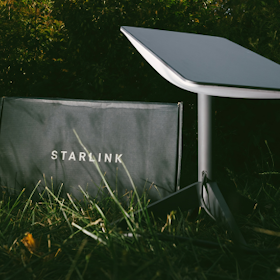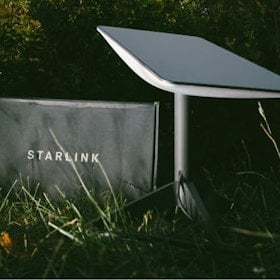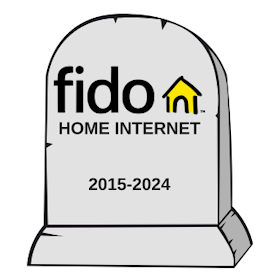
The best internet type for you and your family depends on your location, budget, and speed requirements. Here’s a quick overview:
- Fibre internet: The fastest upload and download speeds but tends to have the highest price tag and limited availability
- Cable internet: Fast internet speeds and is more widely available than fibre though rural customers may not have access
- DSL internet: Slower speeds than cable but is typically available in rural areas
- Satellite internet: Slowest download and upload speeds of the internet types but typically reaches rural locations where other connections aren’t available
In this guide, we’ll compare internet types and help you choose the best one for your needs and priorities.
Internet Connection Types
There are four types of broadband internet connection in Canada: fibre, cable, DSL, and satellite.
Fibre Internet
Fibre internet uses fibre-optic cables made of glass or plastic to send and transfer information via light signals.
This type of internet connection touts the best reliability and fastest download and upload speeds in Canada, with internet speeds of up to 8 Gbps. Fibre internet is best for high-demand households in which multiple family members are engaging in activities like online gaming, video streaming, downloading huge files, and video conferencing. However, these plans are among the most expensive internet plans in the country.
Fibre internet also has the lowest latency or ping, which is the delay between signals. A long latency is responsible for lag and terrible online experience, especially when it comes to gaming.
Pros:
- Blazing-fast upload and download speeds
- Low latency
- Most reliable network
- Great bandwidth for online gaming and streaming
Cons:
- Plans tend to be expensive
- Not widely available
Cable Internet
Much like cable TV, cable internet uses coaxial cables to transfer data through electricity. Cable internet is widely available nationwide due to the infrastructure already being in place for cable TV, although rural customers may find it a bit harder to come by.
Cable internet offers fast speeds at a lower price than fibre internet plans; however, these plans still aren’t cheap, especially when it comes to the plans with the highest speeds. A nice thing about cable, though, is that you have a wide variety of plan options, with speeds ranging from 15 Mbps to 1,500 Mbps so you can find the right balance of speed and cost. Plus, cable tends to offer fairly low latency, which should suffice for most households’ needs.
However, cable is subject to network congestion during peak hours—this means you may experience deprioritization and slower internet speeds, potentially limiting your capabilities. This may be a frustrating disruption if you are having a family movie night or have a Zoom hangout with your friends.
Pros:
- Wide availability
- Fast download speeds
- Fairly low latency
- Reliable network
Cons:
- Slower during network congestion
- More expensive
- May not be available in rural areas
DSL Internet
DSL, which stands for digital subscriber line, is a type of internet that uses landline telephone lines to send information. Because it uses landline cables, it’s the most widely available internet connection, often reaching customers in rural regions.
DSL internet plans tend to run cheaper than fibre and cable plans, although speeds typically top out at 60 Mbps, with many plans offering much slower speeds than that. While DSL provides adequate speeds and latency for browsing, email, social media, and some light streaming, it may not suffice if you have a large household that engages in a lot of streaming or gaming.
Pros:
- Available nearly everywhere, including rural areas
- Affordable
- Isn’t subject to network congestion
Cons:
- Slower than cable and fibre plans
- Speed depends on the distance from your provider
Satellite Internet
Satellite internet utilizes satellites in the sky to transmit information and provide you with an internet connection. Since this internet type doesn’t rely on cables for connection, customers in rural areas have access to satellite internet in the absence of other connection types.
Despite its reach, satellite internet has some significant disadvantages, including its incredibly slow speeds and high latency period. Some Starlink customers are able to reach speeds of 150 Mbps, though network congestion has shown dropping speeds in Canada, causing SpaceX to introduce a high-speed data cap. And satellite plans don’t run cheap either, especially considering that you can get faster speeds for a lower price with cable or DSL.
Pros:
- Available in hard-to-reach locations
Cons:
- Slower
- Expensive
- Prone to latency issues
Other Types of Internet Connection
5G Home Internet
You may be familiar with 5G because of cell phone networks, but with incredibly fast speeds up to 20 Gbps and low latency, 5G home internet is making waves too. In order to access 5G home internet, a cell phone provider installs a cell tower near a wired fiber source and then you receive internet service in your home through those small towers.
5G home internet isn’t widely available yet, but Telus has rolled out a Smart Hub powered by 5G that provides fast internet speeds to rural customers in Western Canada who otherwise don’t have access to high-speed internet.
Pros:
- Incredibly fast speeds
- Accessible to rural customers
- Affordable prices
Cons:
- Not yet widely available
How to Choose the Right Internet Connection Type
There are plenty of plans and providers to choose from, but picking the best option requires a little bit of homework. Below, we break down how to select the best internet connection for your household by factoring in where you live, what you need, and, most importantly, how much you want to spend.
Discern Which Connection Types Are Available Where You Live
The first thing you should consider when choosing the right internet type for your household is your location. Some connection types may not be available where you live. For instance, fibre internet isn’t available Canada-wide. We should see availability increase in coming years as internet providers continue to build out the infrastructure.
The easiest way to figure out what types of internet are available to you is to use WhistleOut’s internet search tool. Simply enter your address into the search bar and select your desired download speeds to view all of the available internet plans and connections near you.Figure Out Your Speed Requirements
The download and upload speeds you need depend on several factors, including:
- How many people are in your household
- How many devices you have connected to the internet (phones, TVs, computers, tablets, etc.)
- What your household uses the internet for
Web browsing, social media, and email don’t require a super fast internet connection; however, things like video conferencing, streaming music, TV, and movies, and online gaming need speedy internet to reduce lag and provide you with a quality online experience.
With every internet connection type except for fibre, download speeds are going to be much faster than upload. You don’t have to worry too much about the upload speeds unless you are online gaming, going live on social media, or frequently video conferencing.
Here’s a quick overview of max speeds for each internet connection type:
- Fibre: 8,000 Mbps (8 Gbps)
- Cable: 1,500 Mbps (1.5 Gbps), with much slower upload speeds than fibre
- DSL: 60 Mbps or less
- Satellite: 12–150 Mbps
Establish a Budget
Once you’ve figured out which ISPs and speeds are available where you live, you can set a budget that feels comfortable for you. Keep in mind, fibre internet is likely going to cost you the most, while cable internet is a nice balance between performance and price. DSL internet is a nice option for budget-minded customers who don’t need the fastest speeds around.
Find the Right Internet Plan for You
Now that you understand the pros and cons of each internet connection type, you can begin to compare internet service providers and plans available near you. Enter your address into our comparison engine and choose your desired internet speeds to view the internet plans available in your area.
Related Articles
Find Better Internet and Phone Plans
Hundreds of internet plans unpacked. All the facts. No surprises.
Internet Providers by Provinces and Territories
- Internet in Alberta
- Internet in British Columbia
- Internet in Manitoba
- Internet in New Brunswick
- Internet in Newfoundland and Labrador
- Internet in Northwest Territories
- Internet in Nova Scotia
- Internet in Nunavut
- Internet in Ontario
- Internet in Prince Edward Island
- Internet in Quebec
- Internet in Saskatchewan
- Internet in Yukon Territory






















































